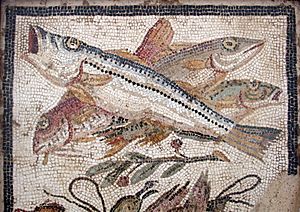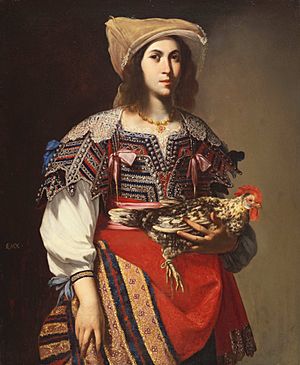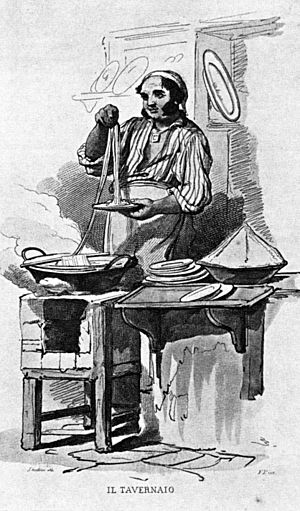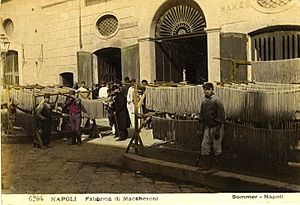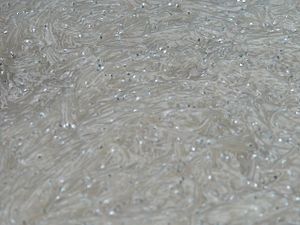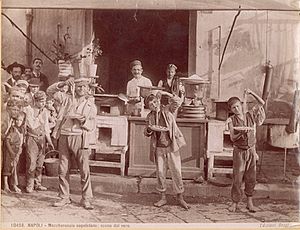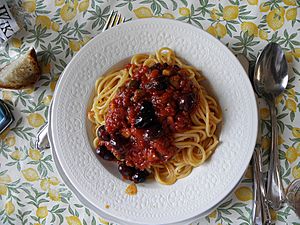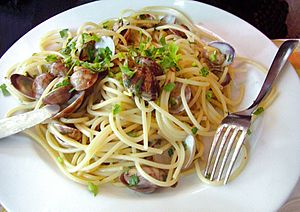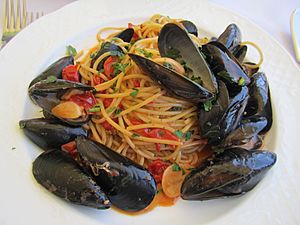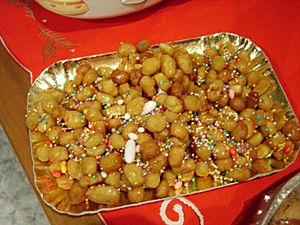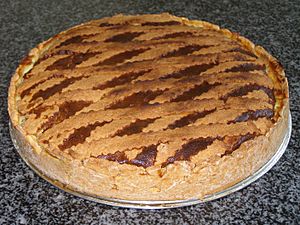Neapolitan cuisine facts for kids
Neapolitan cuisine has very old roots, going all the way back to ancient Greek and Roman times. Over many centuries, different cultures that ruled Naples and its kingdoms, like Aragon and France, added their own flavors and ideas to the food.
Since Naples was the capital of the Kingdom of Naples, its food traditions borrowed a lot from all over the Campania region. This created a great balance between dishes made with farm ingredients like pasta, vegetables, and cheese, and amazing seafood dishes with fish, crabs, and clams. You'll find many recipes influenced by the rich people's cooking, like timballo and sartù di riso, which are fancy pasta or rice dishes. But there are also popular dishes made with simple, healthy ingredients, like pasta e fagioli (pasta with beans) and other pasta dishes with vegetables.
Contents
- A Look Back in Time: History of Neapolitan Food
- Key Ingredients in Neapolitan Cooking
- Bread: A Simple Pleasure
- Delicious Pasta Dishes
- Rice Dishes
- Pizza: Naples' Most Famous Creation
- Fish and Seafood Main Dishes
- Vegetable Main Dishes
- Fried Foods: A Neapolitan Specialty
- Side Dishes
- Savory Pies: Great for Picnics
- Cakes and Desserts: Sweet Treats
- Holiday Food: Special Meals for Special Days
- Fruit: A Sweet Ending
- Wine: Perfect Pairings
- Liqueurs: A Sweet Finish
- Neapolitan Street Food: Food on the Go
- See also
A Look Back in Time: History of Neapolitan Food
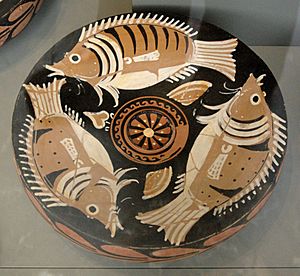
Naples has a super long history, even older than Rome! It has seen many different rulers, including the Greeks, Romans, Goths, and Byzantines, plus many kings from France and Spain. Each group left its mark on how food is made in Naples and the wider Campania area.
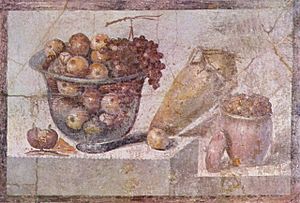
It's not always easy to see how today's Neapolitan food connects to ancient Greek and Roman cooking. But we do have clues! For example, plates found from the Greek period in Magna Graecia (which is southern Italy) show fish and shellfish, meaning people enjoyed seafood back then. Paintings from Pompeii show fruit baskets with figs and pomegranates. An old painting found in the Villa Poppaea at Oplontis even shows a cake, though we don't know what was in it!
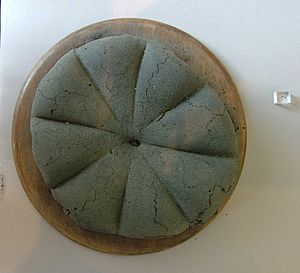
The ancient Roman sauce called garum is a bit like today's Colatura di alici, a special fish sauce from Cetara. Ancient Roman cooking, described by a writer named Apicius, often mixed sweet and sour tastes. This is still seen today in dishes like pizza di scarola (an endive pie) or braciole al ragù (meat rolls in a rich sauce), which use raisins in savory dishes. The struffoli, a Christmas cake, even gets its name from a Greek word meaning "round-shaped."
When the Spanish and French ruled Naples, a big difference grew between the food of the rich and the food of the poor. The rich ate fancy, expensive dishes with lots of meat. The poor used cheaper foods they could grow themselves, like grains and vegetables. Over time, these simple dishes became very tasty and well-known, even though they still used basic ingredients.
Key Ingredients in Neapolitan Cooking
Pasta: A Neapolitan Staple
Naples has so many different kinds of pasta! Pasta wasn't invented here, but some of the best pasta comes from Gragnano, a town close to Naples. This is also where factories first started making pasta on a large scale, learning how to dry and store it. Neapolitan pasta is usually made from durum wheat, which is harder to work with than other types of wheat. In Naples, pasta is traditionally cooked "al dente", meaning it's still a bit firm when you bite it.
Besides classic spaghetti and linguine, popular pastas include paccheri and ziti. Ziti are long, tube-shaped pastas that people usually break by hand before cooking and serve with Neapolitan ragù. When cooking pasta with vegetables, people often use pasta mista (mixed pasta), which is a mix of different broken pasta shapes.
Hand-made gnocchi, made with flour and potatoes, are also very popular.
Tomatoes: The Heart of Many Dishes
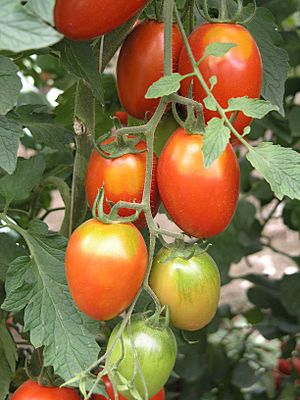
Tomatoes became a part of Neapolitan cooking in the 1700s. By the 1800s, Naples became famous for preserving tomatoes, sending "pelati" (peeled tomatoes) and "concentrato" (tomato paste) all over the world. Families still make their own tomato preserves at home, either as bottled juice or chopped pieces. A special sun-dried tomato paste called "conserva" is cooked for a long time until it becomes a dark red, smooth cream.
Vegetables: Fresh and Flavorful
Many dishes in Campania use vegetables in delicious ways, like parmigiana di melanzane (aubergine pie) or peperoni ripieni (stuffed peppers). Some common local vegetables are friarielli (a type of turnip greens), different kinds of endive and broccoli, and Savoy cabbage. These are often used in minestra maritata, a traditional soup. Various types of beans, chickpeas, and other legumes are also very popular.
Zucchini are used a lot. Large ones are often fried with vinegar and fresh mint (called a scapece). The male flowers of zucchini can also be fried in a savory batter (sciurilli).
Both red and yellow peppers are common, as are small green peppers (not spicy) called peperoncini verdi, which are usually fried.
Salads are a common side dish, especially with seafood. Lettuce, often a crispy local variety, is mixed with carrots, fennel, rucola, and radishes.
The black olives used in Neapolitan cooking almost always come from Gaeta.
Cheese: A Delicious Tradition
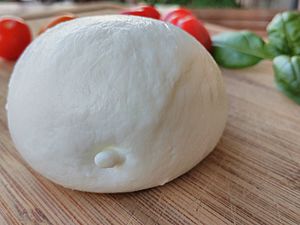
Cheeses, both soft and aged, are a big part of the Italian diet and are very important in Neapolitan cooking. Some recipes come from very old Roman traditions.
Here are some of the most common cheeses:
- ricotta di fuscella: A very fresh and light cheese, originally sold in handmade baskets. It's often used as a filling for pasta.
- ricotta fresca: Eaten fresh or used as a topping, like on pasta with Neapolitan ragù.
- Ricotta secca: A salty, slightly aged ricotta, popular around Easter.
- caciottella fresca: A delicate cheese from the Sorrento peninsula.
- mozzarella di bufala: A fresh cheese made from buffalo milk, mostly from the Aversa region.
- fiordilatte: Similar to mozzarella but made from cow's milk, best from Agerola.
- provola affumicata: A smoked fiordilatte with a light brown outside and yellowish inside.
- bocconcini del cardinale or burrielli: Small mozzarellas kept in clay pots with cream or milk.
- scamorze: White or smoked cheeses.
- burrini di Sorrento: Small provolone cheeses with a butter heart.
- provoloni and caciocavalli: Aged cheeses that come in different varieties.
Seafood: From the Tyrrhenian Sea
Neapolitan cooking uses lots of seafood from the Tyrrhenian Sea. People have always loved the fresh fish here!
Recipes use both cheaper fish, especially anchovies, and other fish for soups like scorfano (scorpionfish), tracina (weever fish), and cuoccio (gurnard). Medium and large fish like spigola (European seabass) and orate (gilt-head bream) are also popular. Very small fish are used too:
- cicinielli: Tiny, clear baby fish, either steamed or fried in a light batter.
- fravaglio: Fish a few centimeters long, often triglia (red mullet) or retunni (picarel), typically fried.
Baccalà (cod) and stockfish, which come from northern Europe, are either fried or cooked with potatoes and tomatoes.
Most cephalopods like octopus, squid, and cuttlefish are used, as well as crustacea like shrimp.
Shellfish like cozze (mussels), vongole (clams), and cannolicchi (razor shells) are used in many seafood meals. Sometimes they are eaten raw, but this is less common now.
It's now against the law to sell and eat sea dates (datteri di mare), because catching them badly damages the coastline rocks, especially near Sorrento.
Meat: Less Common, Still Tasty
Meat isn't used as much in Neapolitan cooking as it is in Northern Italy. The most common types of meat are:
- sausage: salsicce and cervellatine, made with coarsely cut meat.
- Pork liver: Wrapped in a net of pork fat and a bay leaf.
- trippa (tripe) and other less expensive cuts of pork or beef, like the famous 'O pere e 'o musso (pork's foot and cow's nose), and zuppa di soffritto, a spicy soup with tomato and chili pepper.
- braciole: Pork rolls stuffed with raisins, pine nuts, and parsley, held together with toothpicks and cooked in ragù.
- Lamb and goat: Often roasted with potatoes and peas, especially around Easter.
- rabbit and chicken: Often cooked alla cacciatora, which means pan fried with tomatoes.
- beef or other red meat: Cooked with tomatoes for a long time to make it tender, like in Carne alla pizzaiola.
Bread: A Simple Pleasure
The most popular bread is pane cafone, made with natural yeast and cooked in a wood-fired oven. It has a hard crust and large holes inside. Sfilatini are also common, similar to a French baguette but shorter and thicker.
Delicious Pasta Dishes
From simple "pummarola" (tomato sauce) to aglio e uoglio (garlic and oil), and many sauces with vegetables or seafood, all the way to ragù, southern Italy's creativity shines in its pasta dishes.
Simple Pasta Dishes
Dishes traditionally eaten by poorer families often mix pasta with legumes. The most popular are: pasta e fagioli (pasta with beans), pasta e ceci (pasta with chickpeas), pasta e lenticchie (pasta with lentils), and pasta e piselli (pasta with peas). Other vegetables are also paired with pasta, like pasta e patate (pasta with potatoes), pasta e cavolfiore (pasta with cauliflower), and pasta e zucca (pasta with pumpkin).
The traditional way to cook these is to first cook the other ingredients (like frying garlic with oil, then adding beans). Then, water is added and brought to a boil, and the pasta is cooked directly in this mixture. This way, the pasta's starch makes the sauce thicker and creamier, which is a special Neapolitan style. Another hearty dish is pasta simply cooked with cheese and eggs, called pasta caso e ova.
Spaghetti with tomato sauce, black olives from Gaeta, and capers are called spaghetti alla puttanesca. A fun, imaginative recipe from the past is spaghetti alle vongole fujute (spaghetti with "escaped" clams), where the clams are only in your imagination!
Frittata with Spaghetti
A frittata can be made with leftover pasta, either with tomato sauce or plain. The cooked pasta is mixed with raw scrambled egg and cheese, then pan-fried. It can have many other ingredients too. It's cooked on both sides and can be cut into slices, perfect for eating outdoors.
Richer Pasta Dishes
Fancy cooking used pasta for elaborate recipes like timballi, which are like baked pasta pies. These were not for everyday meals.
Richer sauces often used with pasta include:
- The Bolognese sauce: Made with minced carrot, celery, onion, ground beef, and tomato.
- The Genovese sauce: Despite its name, it's not from Genoa. It's made with meat browned with lots of onions and other flavors.
With Neapolitan ragù, the most traditional pasta is ziti, long macaroni that are broken by hand before cooking. Neapolitan ragù is also used with fiordilatte to make gnocchi alla sorrentina, which are then baked in small clay pots.
Seafood Pasta Dishes
Spaghetti, linguine, and paccheri go very well with fish and seafood. These dishes are often served at important meals, like weddings. The most typical ones are:
- Spaghetti alle vongole or other shellfish (clams, mussels, etc.).
- Paccheri con la zuppa di pesce (paccheri with fish soup, using fish like scorfani, cuocci, and tracine).
- Pasta con i calamari, with squid sauce cooked with white wine.
Sometimes, traditional pasta and legume dishes are mixed with seafood, like pasta e fagioli con le cozze (pasta with beans and mussels).
Rice Dishes
The most famous rice dish is sartù di riso, a type of baked rice pie. It's filled with chicken livers, sausage, small meatballs, fior di latte or provola cheese, peas, mushrooms, and either Neapolitan ragù or a white béchamel sauce.
For simpler meals, rice is cooked as riso e verza (rice with cabbage), flavored with small pieces of Parmigiano–Reggiano cheese crusts that melt while cooking.
A seafood rice dish is risotto alla pescatora ("fisherman's risotto"), made with various shellfish (clams, squid, cuttlefish) and shrimp.
Arancini (fried rice balls), though more typical of Sicilian cuisine, are also often eaten in Naples.
Pizza: Naples' Most Famous Creation
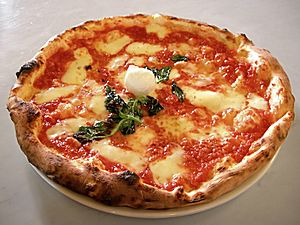
Pizza is the most famous food from Naples! It quickly became popular with everyone, from regular people to kings. Even King Ferdinand I enjoyed cooking pizza in special ovens.
After Italy became one country, the new kings also loved this southern food. A pizzaiolo (pizza maker) named Raffaele Esposito is often given credit for making a special pizza popular. In 1889, he made a pizza for Queen Margherita of Savoy that had the colors of the Italian flag: white mozzarella, red tomato, and green basil. Since then, this pizza has been called the pizza Margherita. Pizza was cheap and filling, so it became very successful very quickly.
While you can make pizza at home, real Neapolitan pizza must be cooked in a wood-fired oven. A skilled pizzaiolo makes the dough thin in the middle and thicker at the edges. The ingredients and olive oil are quickly spread on the dough, and with a swift move, the pizza is put into the hot oven and turned a few times to cook evenly.
Fish and Seafood Main Dishes
One very famous main course is polpi alla luciana, an octopus dish cooked with chili pepper and tomato, from the Santa Lucia area. Octopus is also simply steamed and made into a salad with lemon juice, parsley, and green olives. A richer seafood salad can be made by mixing squid, cuttlefish, and prawns.
Medium-sized fish are cooked all'acqua pazza (meaning "crazy water"), with tomato, garlic, and parsley. Larger fish are simply grilled, sometimes with big prawns for special meals.
Mussels are prepared in different ways: quickly steamed with black pepper (all'impepata) and a few drops of lemon juice, or baked al gratin. Clams and other shellfish are also quickly cooked in a large pan with olive oil and garlic, then served on crusty bread.
Even inexpensive fish can make very tasty dishes. The most popular is anchovy. Some of the best anchovy recipes are:
- Alici dorate e fritte: Boneless anchovies, coated in flour and egg, then deep-fried.
- Alici marinate: Raw anchovies marinated in lemon juice or vinegar, then dressed with olive oil, garlic, and parsley.
- Alici arreganate: Boneless anchovies quickly cooked in a pan with olive oil, lemon juice, and origanum.
Cicenielli, the tiny baby fish, are either steamed and dressed with oil and lemon, or deep-fried in a light batter.
The frittura di paranza (deep-fried fish) is usually made with small local fish like cod, goatfish, and anchovies. It should be eaten very hot, right after it's fried.
Vegetable Main Dishes
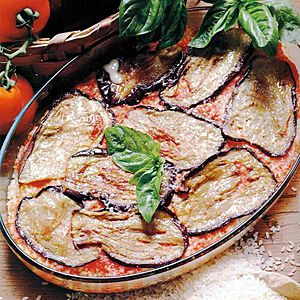
Vegetable dishes can be very rich and fancy. The most famous are:
- The parmigiana di melanzane: An aubergine pie with tomato sauce and fiordilatte cheese.
- The Gatò di patate: A potato pie filled with cheese and salami.
- The peperoni ripieni: Whole peppers stuffed with various fillings.
- The melanzane a barchetta: Aubergines cut in half, scooped out, and filled with different stuffings.
Fried Foods: A Neapolitan Specialty
Besides fried fish, many vegetables are deep-fried with flour and egg (dorate e fritte), like artichoke, zucchini, and cauliflower. Mozzarella can also be prepared dorata e fritta, or in carrozza (meaning "in a carriage"), where it's put between two slices of bread softened in milk, coated in flour and egg, and then fried like a small sandwich.
Typical Neapolitan fried foods also include crocchè (stuffed potato balls coated in breadcrumbs and deep-fried) and Sciurilli (male zucchini flowers fried in a batter). You can often buy these on the streets of Naples from special fried food shops called friggitoria, along with scagliozzi (fried slices of polenta) and pastacresciute (fried bread dough balls).
Side Dishes
After pasta, main courses are often served with side dishes. The most popular ones are:
- Zucchine alla scapece: Deep-fried sliced zucchini dressed with vinegar and fresh mint.
- Melanzane a funghetti: Fried aubergines, either stick-shaped and fried with cherry tomato sauce, or diced and fried without tomato.
- Peperoni in padella: Sliced peppers pan-fried with black Gaeta olives and capers.
- Peperoncini verdi fritti: Local small non-spicy green peppers, dressed with cherry tomato sauce.
- Friarielli: Local vegetable leaves, pan-fried with oil, garlic, and chili pepper. They often go with fried sausages.
Savory Pies: Great for Picnics
Savory pies are easy to eat when you're out and about. The most popular ones are:
- The Pizza di scarola (endive pie): Made with fried scarole (endive) mixed with garlic, pine nuts, raisins, black Gaeta olives, and capers. This vegetable mix fills a simple dough made of flour, water, and yeast.
- The casatiello or tortano: A special pie for Easter holidays, often eaten the day after Easter during outdoor picnics.
Cakes and Desserts: Sweet Treats
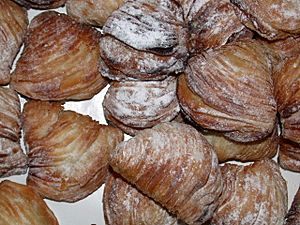
Neapolitan cuisine has a huge variety of cakes and desserts. The most famous ones are:
- babà: A small cake soaked in a sweet syrup, often with rum.
- sfogliatella: Comes in two types: frolla (smooth) or riccia (curly).
- Zeppole: Deep-fried or baked pastries.
- Pastiera: A special cake made for Easter holidays.
- Struffoli: A traditional Christmas cake.
- Delizia al limone: A delicious lemon dessert.
Ice creams are also famous, especially coviglie and spumoni.
Holiday Food: Special Meals for Special Days
Holiday recipes are very special because they are so varied and rich.
Christmas
Christmas Eve dinner is a big family gathering. It usually starts with spaghetti alle vongole, followed by capitone fritto and baccalà fritto (deep-fried eel and stockfish). A side dish is Insalata di rinforzo, a salad with steamed cauliflower, mixed pickled vegetables, spicy and sweet peppers, olives, and anchovies, all dressed with oil and vinegar.
Christmas cakes include:
- Struffoli
- Roccocò
- Mustacciuoli
- Susamielli
Christmas Eve dinner ends with ciociole, which are dried fruits (walnuts, hazelnuts, and almonds), dried figs, and castagne del prete (baked chestnuts).
Christmas lunch typically features minestra maritata or handmade pasta with chicken broth.
Easter Food
The main Easter dishes are Casatiello or tortano, a savory bread pie filled with different types of salami and cheese. This is also eaten the day after Easter for outdoor picnics. Another typical Easter dish is fellata, a platter of salami, capocollo, and salty ricotta. Lamb or goat baked with potatoes and peas are also common. The special Easter cake is pastiera.
Other Holidays
For Carnival, Naples has its own version of lasagna, which doesn't use béchamel sauce like other Italian versions. For dessert, there's Sanguinaccio dolce with savoiardi biscuits, or chiacchiere, which are fried pastries known by different names across Italy.
On November 2nd (All Souls Day), people eat torrone dei morti. Unlike regular torrone (which is made with honey and almonds), this one is made with cocoa and various fillings like hazelnuts, dried and candied fruits, or even coffee.
Fruit: A Sweet Ending
Fruit is often served at the end of a meal. Naples has lots of local fruit. One very popular local fruit is the annurca apple, a type of apple believed to have been grown by the Romans. In the past, slices of watermelon ( 'o mellone) were sold in small street shops. The sweet yellow peach ('o percuoco c' 'o pizzo) is sometimes chopped and added to cold red wine from Monte di Procida, making it a bit like Spanish sangria.
Wine: Perfect Pairings
Many wines from Campania go perfectly with the local food. Famous white wines include Greco di Tufo, Falanghina, Fiano di Avellino, and Asprinio di Aversa. The most famous red wines are Aglianico, Taurasi DOCG, and Campi Flegrei Piedirosso (also called pere 'e palummo). There's also Lacryma Christi from Vesuvius, which comes in both white and red.
Liqueurs: A Sweet Finish
Most big meals end with coffee and a liqueur. Limoncello is now famous worldwide. In the past, a favorite was liquore ai quattro frutti, made with lemon, orange, tangerine, and limo (a local type of bergamot orange, now very rare). Nocillo is also very popular and is a favorite bitter liqueur.
Neapolitan Street Food: Food on the Go
In Naples, buying and eating food on the streets has been a tradition for a very long time, possibly since Roman times. You can still buy typical fried foods in small shops today, like Pastacresciute (deep-fried bread dough balls), Scagliozzi (deep-fried polenta slices), and sciurilli (deep-fried male zucchini flowers), or deep-fried aubergines.
Pizza is also made in smaller sizes to be eaten on the street, called pizza a libretto. You can still find this in pizzerias in Naples' historic center. In some shops, called carnacuttari, you can find different types of tripe, 'O pere e 'o musso (pork's foot and cow's nose), or the old zuppa 'e carnacotta (tripe soup).
Near Mergellina, you can still find shops selling taralli nzogna e pepe (salty biscuits with pork fat and black pepper). The old 'o broro 'e purpo (octopus broth) is now very rare to find.
A few decades ago, street vendors sold 'o spassatiempo, a mix of baked hazelnuts, pumpkin seeds, toasted chickpeas, and lupins in salty water.
|
See also
 In Spanish: Gastronomía de Nápoles para niños
In Spanish: Gastronomía de Nápoles para niños


